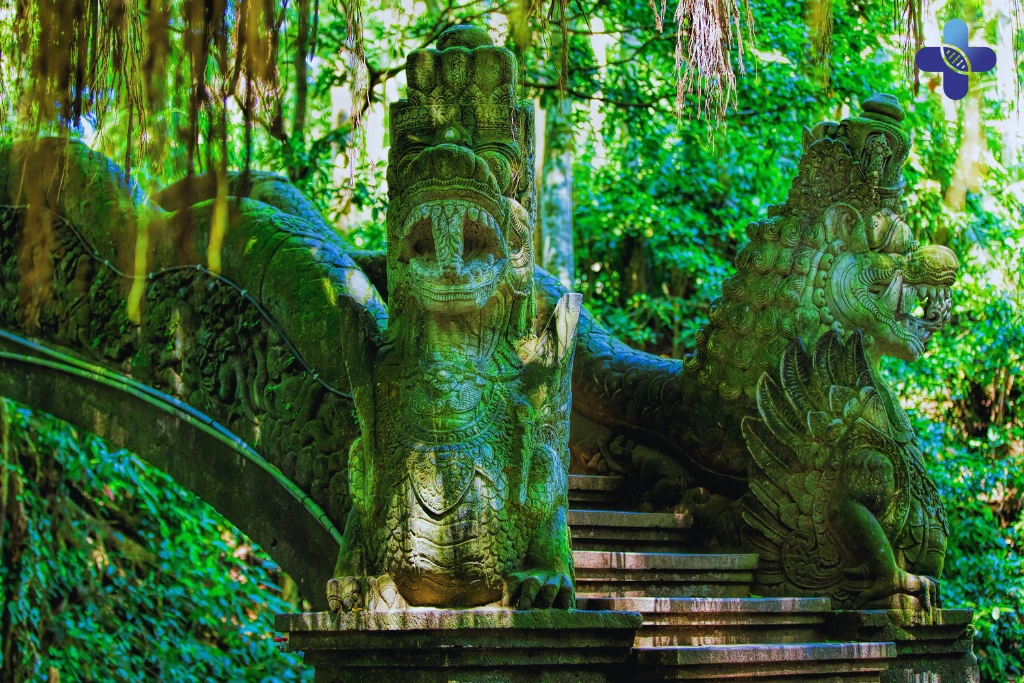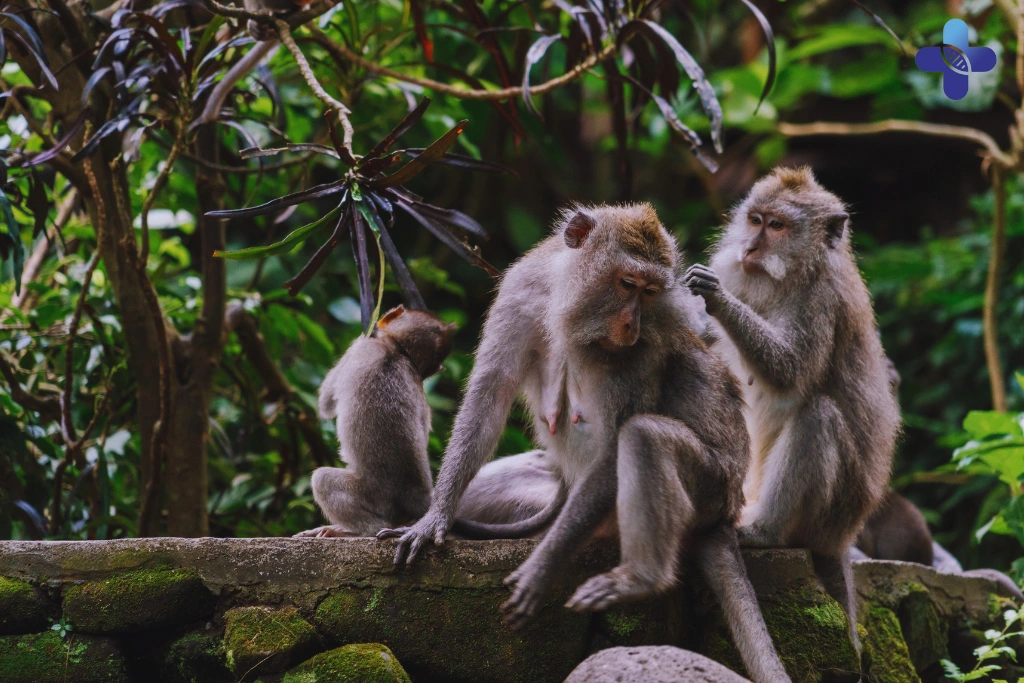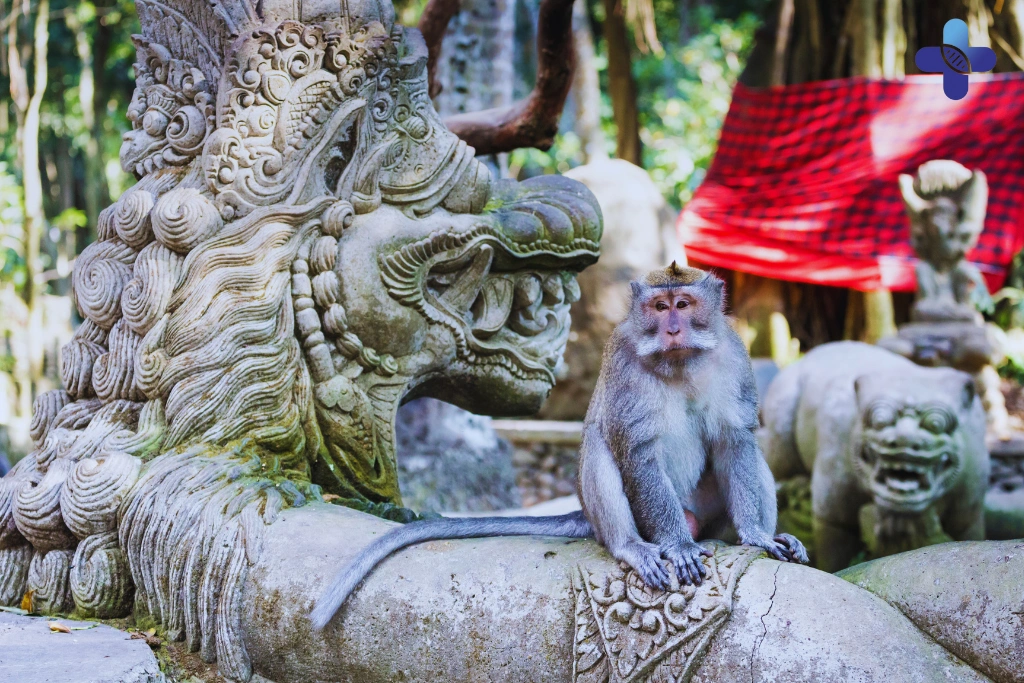Planning a visit to Bali’s famous monkey sanctuary? These 10 essential tips for a safe visit to the Ubud Monkey Forest will help you make the most of your adventure. From what to wear and bring, to how to interact (or not interact) with the monkeys, this guide ensures you’ll enjoy the magic of the Sacred Monkey Forest while staying safe and respectful in this sacred habitat. As a trusted Bali medical clinic, Life Everyouth Clinic is committed to helping travelers stay informed and protected during their journey. With our experience as a leading medical clinic in Bali, Life Everyouth Bali encourages every visitor to be aware, prepared, and respectful—so you can fully enjoy one of Ubud’s most unforgettable experiences.
A Visitor’s Guide to Ubud’s Sacred Monkey Forest: 10 Tips for a Safe & Magical Experience

Stepping into the Sacred Monkey Forest Sanctuary in Ubud is like walking into a storybook. With towering banyan trees, ancient temple ruins, and hundreds of long-tailed macaques roaming freely, the forest radiates a sense of wonder that captivates every visitor. It’s not just a tourist attraction—it’s a sacred ecosystem and spiritual space where nature and culture exist in harmony. For many travelers, this becomes a highlight of their Bali adventure.
But such a magical setting also requires awareness and care. These monkeys may seem playful and charming, but they are still wild animals. That’s why following the right Ubud Monkey Forest tips is essential—not just for your safety, but for the protection of the monkeys and their home. At Life Everyouth Clinic, a trusted Bali medical clinic, we’ve seen firsthand how a fun visit can quickly become stressful when precautions aren’t taken. As a leading medical clinic in Bali, Life Everyouth Bali encourages every traveler to stay informed and respectful, so your encounter with the forest remains a beautiful, unforgettable memory—not a medical emergency.
Before You Go: Essential Preparation
Before entering the Ubud Monkey Forest, taking a few minutes to prepare can make the difference between a smooth visit and a stressful one. This sacred site is far more than a beautiful photo spot—it’s an active spiritual sanctuary and the protected home of over 1,200 long-tailed macaques. Respecting the space through proper preparation not only honors Balinese culture, but also protects your health and peace of mind. At Life Everyouth Clinic, a trusted Bali medical clinic, we often remind travelers that prevention is the best way to avoid unnecessary medical visits during their holiday.
What to Wear
Dress with mindfulness and modesty. The Sacred Monkey Forest contains temple areas still used for Balinese Hindu ceremonies, and respectful attire is expected—even if you don’t plan to enter temple grounds. Light, breathable clothing that covers the shoulders and knees is highly recommended. Aside from being culturally appropriate, it shields your skin from sunburn and accidental scratches caused by foliage or playful monkeys. At Life Everyouth Bali, we often see tourists arrive with cuts from slipping on wet paths, so closed-toe, non-slip shoes are essential for safe movement on mossy stone walkways.
Avoid loose sandals or flip-flops, which can easily slip off or cause trips. A sarong or lightweight scarf may come in handy for temple visits or as added sun protection. If you’re visiting during Bali’s rainy season, opt for a compact poncho instead of an umbrella—open umbrellas can startle nearby monkeys, leading to unexpected reactions. Preparing the right outfit shows cultural sensitivity and adds a layer of practical safety.
What NOT to Bring
The macaques of Ubud are intelligent, observant, and bold. Over time, they’ve learned that plastic bags, bottles, and shiny accessories often mean food—or at least something fun to snatch. Bringing the wrong items can quickly shift a peaceful visit into a chaotic one. At Life Everyouth, a leading medical clinic in Bali, we’ve treated injuries caused by monkeys grabbing unsecured objects or reacting to what they perceive as threats.
Do not bring plastic bags, as their sound draws attention instantly. Avoid wearing sunglasses on your head, dangling jewelry, large earrings, or anything shiny that might tempt a monkey to leap. Bottled drinks, protein bars, and even tightly sealed snacks should be left behind—monkeys can smell them and will act fast. If you carry a backpack or crossbody bag, ensure it is zipped tight, with nothing sticking out. And never store food in your pockets—monkeys are clever and persistent. By packing thoughtfully, you greatly reduce your chances of an unwanted encounter.
Preparing with respect and awareness sets the tone for a peaceful, enriching experience in one of Bali’s most unique environments. And if you ever need reassurance or guidance, Life Everyouth Clinic, your trusted medical clinic in Bali, is always here to help before, during, or after your journey.
Inside the Forest: 10 Rules for a Great Visit

Once you step beyond the gates of the Ubud Monkey Forest, you are no longer just a tourist—you are a guest in the home of over a thousand long-tailed macaques. These intelligent and highly social animals are fascinating to observe, but they require space, calmness, and respect. These ten essential tips will help you navigate the sanctuary safely and ensure your experience remains magical—not memorable for the wrong reasons.
1. Secure Your Bag
Your bag is the first thing monkeys will notice. They associate it with food, shiny objects, or fun. Backpacks should be zipped at all times and worn front-facing when possible, especially in crowded areas. Avoid leaving straps dangling or wearing loosely slung bags. Even a closed bag with tempting objects in outer mesh pockets can invite unwanted monkey interaction.
2. Don’t Bring Food
The sanctuary strictly prohibits food inside, and for good reason. Monkeys can smell snacks—even through wrappers—and may act aggressively to get to it. Hiding a banana or protein bar “just in case” is not only unsafe, it’s disrespectful to the forest’s rules. Feeding the monkeys disrupts their natural behavior and can lead to increased aggression toward visitors.
3. Walk Calmly and Quietly
The Monkey Forest isn’t a zoo—it’s a natural environment with very real, reactive animals. Running, stomping, or yelling can trigger defensive or territorial behavior. Keep your movements slow and your voice soft. A calm presence is less likely to attract monkeys or provoke unexpected reactions.
4. No Eye Contact
In monkey social behavior, prolonged eye contact is often seen as a threat. Even if you’re admiring them from a distance, locking eyes with a macaque may be interpreted as a challenge. Instead, observe respectfully with a soft gaze or look slightly to the side. This one simple action can help prevent misunderstandings.
5. Do Not Touch the Monkeys
It might be tempting—especially when a monkey sits close by or reaches toward you. But no matter how friendly they appear, never attempt to pet or hold them. Touching can be seen as invasive or aggressive. Monkeys may bite or scratch in response, which poses serious health risks.
6. Stay Calm if a Monkey Jumps on You
Sometimes, a monkey may leap onto your shoulder or bag out of curiosity. Don’t scream, flail, or try to push them off. Sudden reactions can escalate the situation. Instead, freeze, breathe, and let them inspect briefly. Most will jump off on their own. If not, calmly call for staff assistance.
7. Listen to the Staff
The staff at the Ubud Monkey Forest are trained professionals with daily experience managing macaque behavior. If they tell you to move, stop, or change direction, follow their instructions immediately. Their goal is not only to protect you, but also to minimize stress for the animals.
8. Supervise Children Closely
Children often react unpredictably—and so do monkeys. If you’re visiting with little ones, ensure they stay close, hold your hand, and understand the rules. No running, shouting, or waving objects around. Explain ahead of time that the monkeys are not toys or pets, and that quiet observation is the best way to enjoy the experience.
9. Don’t Try to Take Selfies
Selfie culture can turn dangerous when wild animals are involved. Leaning in too close for a photo can be misinterpreted by a monkey as a threat. If you truly want a memorable shot, ask a staff member to help position you at a safe distance. Never attempt to force a photo, lure a monkey, or use food to get them closer.
10. Know the “What If” Scenario
Even with all precautions, minor incidents can occur. A monkey may scratch you while grabbing at something, or nip in response to an accidental gesture. It’s important to know exactly what to do. Stay calm, report to staff immediately for basic first aid, and then follow these emergency first-aid steps for monkey bites to ensure proper treatment.
The “What If” Scenario: Your Emergency Action Plan
Even with the best preparation and respectful behavior, minor incidents can still happen inside the Ubud Monkey Forest. Monkeys are wild animals with fast reflexes and unpredictable instincts. A scratch or bite may occur in seconds—especially if a monkey feels startled, threatened, or tries to grab an item from you. The key is to stay calm. Panic will only escalate the situation and delay the steps you need to take next.
If you or someone in your group is bitten or scratched, notify a staff member immediately. The Ubud Monkey Forest team is trained to respond to these situations and will guide you to the nearest first-aid point. There, the wound will be cleaned and assessed. But remember: this is only the first step. It’s essential to follow up at a professional Bali medical clinic like Life Everyouth Clinic, where proper wound care, infection control, and access to the rabies vaccine in Bali are available for both tourists and long-stay visitors.
As a trusted medical clinic in Bali, Life Everyouth Bali regularly provides care for travelers who have been scratched or bitten by monkeys. Our team ensures the wound is thoroughly cleaned and offers post-exposure prophylaxis (PEP) if needed. This may include tetanus boosters, antibiotics, and importantly, the rabies vaccine—a crucial protection for anyone exposed to animal bites. For a step-by-step breakdown of what to do, follow these emergency first-aid steps for monkey bites. Knowing what to expect and where to go can make your response quicker, calmer, and far more effective.
Conclusion Ubud Monkey Forest: 10 Essential Tips for a Safe Visit (2025)

The Ubud Monkey Forest is more than just a tourist destination—it’s a living sanctuary where spiritual tradition, ecological conservation, and natural wonder come together. By following the basic rules for Ubud Monkey Forest visitors—like dressing appropriately, avoiding direct contact with monkeys, and respecting the staff—you not only protect yourself, but also contribute to the peaceful balance of this sacred place. The monkeys are not performers; they are wild animals living in a protected habitat that demands awareness and respect.
Whether you’re visiting solo, with friends, or bringing children along, applying these Ubud Monkey Forest tips will help you enjoy the experience with confidence and care. From Ubud Monkey Forest safety practices to knowing what to do in case of a monkey bite in Ubud, preparation is key. And if you ever need support, Life Everyouth Clinic is here as your trusted Bali medical clinic—ready to guide and care for you during your stay. Let this moment in the forest be more than a photo opportunity—let it be a gentle lesson in mindfulness, nature, and the kind of travel that leaves no harm behind.
Frequently Asked Questions Ubud Monkey Forest: 10 Essential Tips for a Safe Visit (2025)
What is the entrance fee for the Ubud Monkey Forest in 2025?
As of mid-2025, the entrance fee is typically around IDR 80,000 for adults and IDR 60,000 for children. However, prices may vary slightly depending on the season or updated policies. It’s always best to check the official Ubud Monkey Forest website before your visit to confirm the latest rates and whether online booking is required during peak travel periods.
What are the opening hours?
The Sacred Monkey Forest Sanctuary is generally open daily from 9:00 AM to 6:00 PM, with the last ticket sales closing around 5:00 PM. Arriving earlier in the day is recommended to avoid crowds and intense afternoon heat. Early mornings also offer better lighting and a more peaceful atmosphere for photography and observation.
Is it okay to bring a backpack?
Yes, you can bring a backpack, but you must keep it zipped and securely fastened at all times. Avoid carrying anything in outer mesh pockets, and remove dangling charms, keychains, or water bottles, as monkeys are adept at spotting and grabbing such items. If possible, use a small crossbody or front-facing bag to minimize risk.
Can I get a selfie with a monkey?
Taking a selfie with a monkey may sound like a great idea, but it often involves getting too close, which can stress the animal and put you at risk. Instead, observe from a safe distance or ask sanctuary staff for help. They are sometimes able to guide a safe, staged photo opportunity without provoking the monkeys or breaking the rules.
Are the monkeys aggressive?
Generally, the monkeys are used to being around humans and are not naturally aggressive. However, they are still wild animals. They may become assertive if they see food, feel cornered, or sense a threat—intentional or not. Following key Ubud Monkey Forest tips like no food, no eye contact, and no sudden movement is the best way to prevent unwanted interactions.
How long should I spend there?
Most visitors find that 1.5 to 2 hours is ideal for exploring the sanctuary at a relaxed pace. This gives you time to walk the main paths, take in the temple architecture, observe monkey behavior, and enjoy the lush forest setting. If you plan to take photos or visit with young children, allow a bit more time for rest and supervision.
Is it suitable for young children?
Yes, it can be a great experience for children—if they are under continuous adult supervision. Children must be briefed on the rules beforehand and should never run, scream, or wave objects around, as this can startle or provoke the monkeys. Holding their hand at all times and staying close is essential for everyone’s safety.
What should I do if a monkey shows its teeth at me?
A monkey showing its teeth is not smiling—it’s giving a warning. Do not smile back, as showing your teeth may be perceived as aggression. Instead, avert your gaze, keep your body still, and back away slowly. Avoid loud sounds or sudden movements. Respecting these signals helps de-escalate potential tension.
I got a small scratch, should I be worried?
Yes, any scratch or bite from a monkey—no matter how small—should be treated seriously. Clean the wound immediately with soap and water, and inform sanctuary staff for basic first aid. After that, seek professional medical evaluation to determine whether post-exposure treatment is needed. For a full step-by-step guide, please read our emergency first-aid guide for monkey bites.
Are there first-aid stations inside the forest?
Yes, the Ubud Monkey Forest has trained staff and basic first-aid stations on-site. They can assist with immediate cleaning and dressing of wounds. However, this should always be followed by a visit to a medical clinic to assess the risk of infection and begin further treatment if necessary, especially in the case of deeper bites or scratches.
